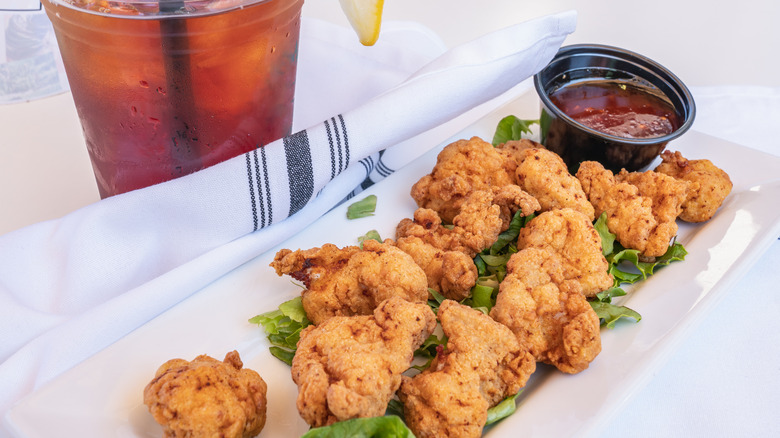Canned Alligator Is A Real Thing, But What Is It Used For?
We may receive a commission on purchases made from links.
If you can cook it, you can probably put it in a can. Indeed, the food world is full of all manner of things you wouldn't expect to find canned, from brown bread to a whole chicken. So it's no surprise that canned alligator is a thing (or is it?).
Granted, you won't be able to find it on just any old grocery store shelf. But with alligator being a definite ingredient in much of Southern and Cajun cooking, and with so many delicious recipes for it, it seems appropriate that somewhere, you'd be able to find it in a convenient can, ready to open and drop into whatever dish you might have in mind. What kinds of dishes might these be? In a broad sense, any dish that either calls for alligator, or in which alligator might be subbed into (it's commonly compared to chicken so chicken dishes are a safe bet).
"Heat and Serve Over Rice" is what is recommended on a page for Dale's Cajun Style Alligator in a Can. That sounds rather specific until you realize that there are countless dishes — especially in Southern and Cajun cuisine — whose primary components are meat and rice. But serving over rice, with any variety of vegetables and spices and even other kinds of meat, is only one set of the many possibilities for canned gator.
From tenders to jambalaya
Alligator, or at least the much-preferred tail, consists of white meat, and as the tenderest and juiciest part of the animal, is often said to taste like chicken. No surprise then that it shows up in dishes that would also apply to chicken. Chicken tenders become gator tenders and the same applies to nuggets.
It's not difficult to imagine a canned version of gator meat being just as useful as its fresher counterpart in these fried recipes, though it's not unlikely that you'll have a bit of extra sodium and whatever liquid the animal was canned with to preserve it. Still, frying canned gator will absolutely be possible.
Certain brands of canned alligator meat, such as that sold by Newport Jerky Company, are canned in gravy or sauce. While this would make frying less than ideal, it sounds perfect for serving over that aforementioned rice, in whatever style, including jambalaya, all of which the seller recommends on the item's Amazon page.
Of course, like with most foods, canned alligator meat won't have quite the same benefits in terms of taste and nutrition as the fresh version. Also, certain parts of the alligator — very much edible parts — have yet to make their canned debut.
What about the legs and the ribs?
Naturally, all of the recipes mentioned thus far seem best suited for the tail of the alligator, or at least other forms of boneless canned gator. This, however, is not the only way to eat alligator. Steaks and Game mentions several parts of the gator that folks also like to eat. Yes, there's the popular tail, which can be deboned and chopped up into smaller pieces, but it can also be sliced into larger portions like steaks or filets. This is the kind of cut that doesn't fit inside a can, unless that can is a lot bigger than the ones typically found on grocery store shelves.
Also mentioned are the legs and ribs of the alligator, frequently eaten off the bone in the same way you would a chicken drumstick or a pork rib. While bone-in canning is not unheard of — think, for example, of that canned whole chicken – our own searches for canned bone-in gator has yielded no results.
Much easier was finding these cuts sold either in fresh or frozen form, or vacuum-sealed, as they are on the Louisiana Crawfish Company website. All of which is to say that while you may not be able to find the exact cut of gator you're looking for in a can, you should still be able to find it. But if you're looking for a quick bite of gator, the canned variety should suit you just fine.


